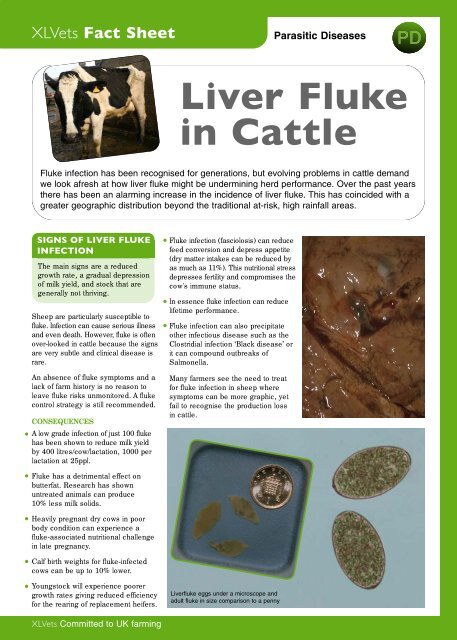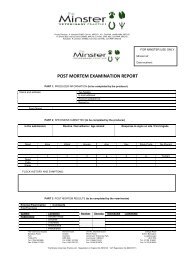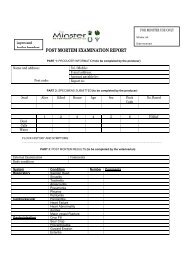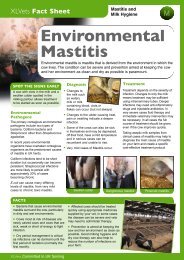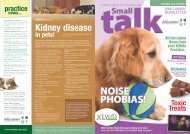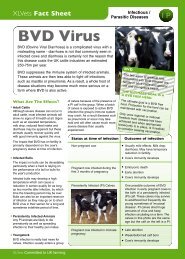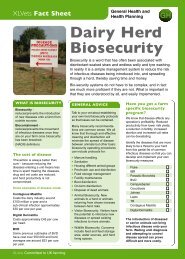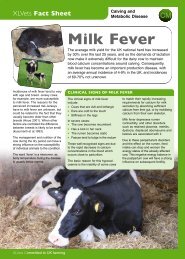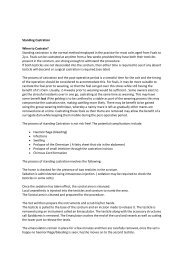Liver Fluke in Cattle - Cheviot Futures
Liver Fluke in Cattle - Cheviot Futures
Liver Fluke in Cattle - Cheviot Futures
Create successful ePaper yourself
Turn your PDF publications into a flip-book with our unique Google optimized e-Paper software.
XLVets Fact Sheet<br />
Parasitic Diseases<br />
PD<br />
<strong>Liver</strong> <strong>Fluke</strong><br />
<strong>in</strong> <strong>Cattle</strong><br />
<strong>Fluke</strong> <strong>in</strong>fection has been recognised for generations, but evolv<strong>in</strong>g problems <strong>in</strong> cattle demand<br />
we look afresh at how liver fluke might be underm<strong>in</strong><strong>in</strong>g herd performance. Over the past years<br />
there has been an alarm<strong>in</strong>g <strong>in</strong>crease <strong>in</strong> the <strong>in</strong>cidence of liver fluke. This has co<strong>in</strong>cided with a<br />
greater geographic distribution beyond the traditional at-risk, high ra<strong>in</strong>fall areas.<br />
●<br />
SIGNS OF LIVER FLUKE<br />
INFECTION<br />
The ma<strong>in</strong> signs are a reduced<br />
growth rate, a gradual depression<br />
of milk yield, and stock that are<br />
generally not thriv<strong>in</strong>g.<br />
Sheep are particularly susceptible to<br />
fluke. Infection can cause serious illness<br />
and even death. However, fluke is often<br />
over-looked <strong>in</strong> cattle because the signs<br />
are very subtle and cl<strong>in</strong>ical disease is<br />
rare.<br />
An absence of fluke symptoms and a<br />
lack of farm history is no reason to<br />
leave fluke risks unmonitored. A fluke<br />
control strategy is still recommended.<br />
CONSEQUENCES<br />
A low grade <strong>in</strong>fection of just 100 fluke<br />
has been shown to reduce milk yield<br />
by 400 litres/cow/lactation, 1000 per<br />
lactation at 25ppl.<br />
●<br />
●<br />
●<br />
<strong>Fluke</strong> <strong>in</strong>fection (fasciolosis) can reduce<br />
feed conversion and depress appetite<br />
(dry matter <strong>in</strong>takes can be reduced by<br />
as much as 11%). This nutritional stress<br />
depresses fertility and compromises the<br />
cow's immune status.<br />
In essence fluke <strong>in</strong>fection can reduce<br />
lifetime performance.<br />
<strong>Fluke</strong> <strong>in</strong>fection can also precipitate<br />
other <strong>in</strong>fectious disease such as the<br />
Clostridial <strong>in</strong>fection ‘Black disease’ or<br />
it can compound outbreaks of<br />
Salmonella.<br />
Many farmers see the need to treat<br />
for fluke <strong>in</strong>fection <strong>in</strong> sheep where<br />
symptoms can be more graphic, yet<br />
fail to recognise the production loss<br />
<strong>in</strong> cattle.<br />
●<br />
●<br />
●<br />
<strong>Fluke</strong> has a detrimental effect on<br />
butterfat. Research has shown<br />
untreated animals can produce<br />
10% less milk solids.<br />
Heavily pregnant dry cows <strong>in</strong> poor<br />
body condition can experience a<br />
fluke-associated nutritional challenge<br />
<strong>in</strong> late pregnancy.<br />
Calf birth weights for fluke-<strong>in</strong>fected<br />
cows can be up to 10% lower.<br />
●<br />
Youngstock will experience poorer<br />
growth rates giv<strong>in</strong>g reduced efficiency<br />
for the rear<strong>in</strong>g of replacement heifers.<br />
<strong>Liver</strong>fluke eggs under a microscope and<br />
adult fluke <strong>in</strong> size comparison to a penny<br />
XLVets Committed to UK farm<strong>in</strong>g
XLVets <strong>Liver</strong> <strong>Fluke</strong> <strong>in</strong> <strong>Cattle</strong><br />
<strong>Liver</strong> <strong>Fluke</strong><br />
Life Cycle<br />
<strong>Liver</strong> <strong>Fluke</strong> (Fasciola hepatica) is a<br />
flat, leaf-like (3.5cm) parasite found<br />
<strong>in</strong> the liver of graz<strong>in</strong>g animals. Eggs<br />
from adult female fluke pass <strong>in</strong> the<br />
dung to contam<strong>in</strong>ate pasture.<br />
When conditions are suitable - damp<br />
and warm (above 10 o c) - the eggs<br />
hatch to form mobile larvae that seek<br />
out mud snails to complete their life<br />
cycle.<br />
The presence of the amphibious mud<br />
snails determ<strong>in</strong>es the distribution of<br />
fluke. So the highest risk graz<strong>in</strong>g are<br />
wet areas and around pools of water.<br />
The larvae multiply <strong>in</strong> the snails and<br />
emerge to attach to the grass as cysts.<br />
The graz<strong>in</strong>g animal <strong>in</strong>gests the cyst<br />
where it breaks out as an immature<br />
fluke to make its way to the liver.<br />
The fluke tunnel through the liver and if<br />
conditions favour, then a mass hatch<br />
and <strong>in</strong>fection can cause severe and<br />
permanent damage.<br />
The adult fluke live <strong>in</strong> the bile ducts of<br />
the liver where they feed on blood. This<br />
can amount to half a millilitre per adult<br />
fluke per day expla<strong>in</strong><strong>in</strong>g the anaemia<br />
exhibited by <strong>in</strong>fected animals.<br />
Parasitic Diseases<br />
DIAGNOSIS<br />
<strong>Fluke</strong> diagnosis is not straight<br />
forward and needs careful<br />
<strong>in</strong>terpretation, so speak to your<br />
vet.<br />
<strong>Fluke</strong> egg counts from faecal<br />
samples <strong>in</strong>dicate <strong>in</strong>fection but<br />
egg production is sporadic.<br />
Blood sampl<strong>in</strong>g a random group<br />
(young homebred stock would be<br />
a good <strong>in</strong>dicator) can reveal the<br />
evidence of fluke <strong>in</strong>fection.<br />
Post mortem/slaughterhouse<br />
feedback provides a direct<br />
report of fluke level <strong>in</strong><br />
condemned livers. Many more<br />
abattoirs are do<strong>in</strong>g this now.<br />
PD<br />
TREATMENT<br />
Treatment is very effective but<br />
needs to be targeted to the fluke<br />
season and to recognise the<br />
variable efficacy of product for the<br />
different stages of fluke (early<br />
immature, immature and adult).<br />
Also the milk withhold must be considered<br />
and often means treatment<br />
is targeted <strong>in</strong> the dry period. <strong>Fluke</strong><br />
treatments come as drenches and<br />
<strong>in</strong>jections and are also available <strong>in</strong><br />
comb<strong>in</strong>ation with wormers. The<br />
recognition of fluke and a strategic<br />
approach to treatment should be a<br />
component of herd health plan<br />
reviews. A little <strong>in</strong>vestment <strong>in</strong><br />
health will go a long way to<br />
alleviat<strong>in</strong>g the production loss.<br />
For further <strong>in</strong>formation contact your local XLVets practice:<br />
XLVets Committed to UK farm<strong>in</strong>g. Go to www.xlvets.co.uk


